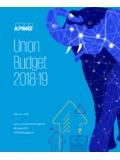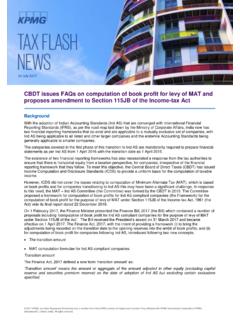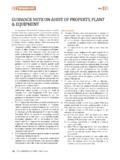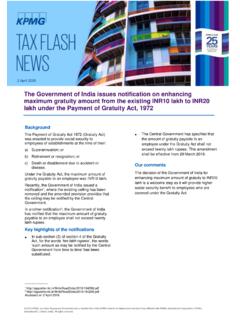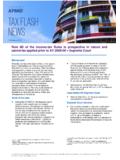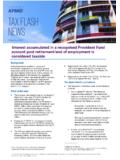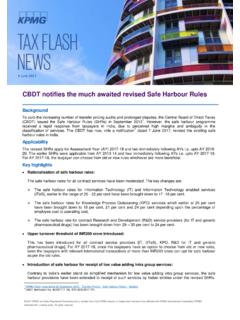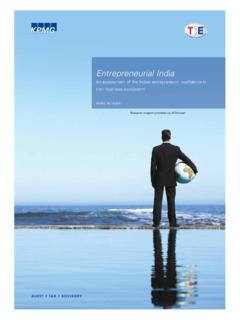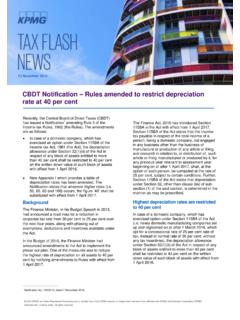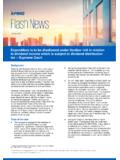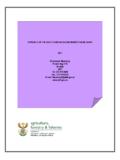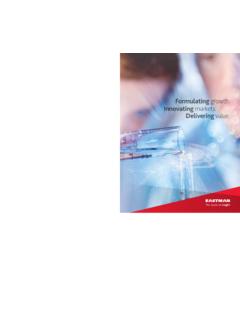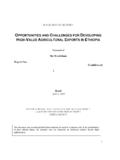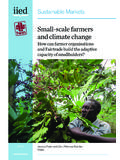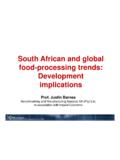Transcription of ADVISORY SERVICES - KPMG
1 ADVISORY SERVICESThe Indian sugar IndustrySector Roadmap 2017 June 2007 KPMG IN INDIAThe indian sugar industry is a key driver of rural development, supporting India's economic growth. The industry is inherently inclusive supporting over 50 million farmers and their families, along with workers and entrepreneurs of almost 500mills, apart from a host of wholesalers and distributors spread across the industry is at a cross roads today, where it can leverage opportunities created byglobal shifts in sugar trade as well as the emergence of sugarcane as a source of renewable energy, through ethanol and cogeneration. While some of these opportunities have been well researched in the past, there was a need to assess the potential for India and to develop a comprehensive and actionable roadmap that could enable the Indian industry to take its rightful place as a food and energy producer for one of the world's leading economies.
2 Indian sugar Exim Corporation (ISEC), an apex body with both Indian sugar Mills Association (ISMA) and National Federation of Cooperative sugar Factories (NFCSF) as its constituents, has sponsored KPMG for developing this roadmap. Over last few months, KPMG had extensive discussions with stakeholders across the valuechain farmers, millers, international traders and policy makers. These weresupported with data collation from various sources, a comprehensive consumer study and expert views from international sugar research agencies. This report is the culmination of all these efforts and insights. The report identifies imperatives for industry stakeholders, both from business and regulatory impact of these imperatives will enable greater prosperityfor millions of farmers and drive future growth of the industry in domestic and international markets, while contributing towards food and energy security for appreciate the contribution of the KPMG team in developing this roadmap and the industry stakeholders and policy makers now need to work together to enable its successful RamababuJayanthilal B.
3 PatelPresident, ISMAP resident, NFCSFM essage 2007 KPMG, an Indian partnership and a member firm of the KPMG network of independent member firms affiliated with KPMG International, a Swiss cooperative. All rights sugar industry is a critical industry , as on one hand it SERVICES the domestic market , the largest in the world and on the other hand, it supports 50 million farmersand their families. It is the second largest agro based industry in India. Emerging businesses like fuel ethanol and structural changes globally including the removal of EU subsidies have provided new horizons for the sector todayhas transformational opportunities that would enable it not only to continue to service the domestic markets but also emerge as a significant carbon credit and power producer and support an ethanol blending programme of E10 and the sugar regulations would have to evolve to facilitate the transformationof the sector. We believe in the potential of the sector and have therefore partnered with ISEC in conceptualizing the sector roadmap the past, while there have been major studies conducted on the regulatoryaspects of the sector, there have been none which have provided a comprehensiveroadmap incorporating both the business and regulatory perspectives.
4 This studyaims at providing that comprehensive roadmap. It has been a challenging task, but we've received tremendous support from the industry in developing this study. We are confident of the potential of the transformation opportunities and if the sector were to traverse the recommended roadmap, it would move towards the shared vision. We are grateful to ISEC for giving us the opportunity and to all stakeholders who contributed to this MahajanExecutive Director, KPMG ADVISORY SERVICES Pvt. 2007 KPMG, an Indian partnership and a member firm of the KPMG network of independent member firms affiliated with KPMG International, a Swiss cooperative. All rights Document is CONFIDENTIAL and its circulation and use are RESTRICTED. 2007 KPMG, the Indian member firm of KPMG International, a Swiss cooperative. All rights reserved. KPMG and the KPMG logo are registered trademarks of KPMG International, a Swiss cooperative. Printed in IndiaContents1 Executive Summary12 Objectives and Approach203 Shared Vision244 indian sugar industry Sector Snapshot285 Global sugar industry - Key Comparative Analysis526 Business Roadmap Transformation Opportunities667 Predictable Patterns Learning From Other Industries11 68 Regulatory Roadmap1269 Implementation Plan18410 Way Forward198 Abbreviations199 References202In an era where there is a need for inclusive growth, the sugar industry is amongst the few industries that have successfully contributed to the rural economy.
5 It has done so by commercially utilizing the rural resources to meet the large domestic demand for sugar and by generating surplus energy to meet the increasing energy needs of India. In addition to this, the industry has become the mainstay of the alcohol industry . The sector supports over 50 million farmers and their families, and 1delivers value addition at the farm side . In general, sugarcane price accounts for2approximately 70 percent of the ex-mill sugar price .The sector also has a significant standing in the global sugar space. The Indian domestic sugar market is one of the largest markets in the world, in volume terms. India is also the second largest sugar producing geography. India remains a keygrowth driver for world sugar , growing above the Asian and world consumption growth , in most of the key geographies like Brazil and Thailand, regulations have a significant influence on the sugar sector.
6 Perishable nature of cane, small farmlandholdings and the need to influence domestic prices; all have been the drivers forregulations. In India, too, sugar is highly regulated. Since 1993, the regulatoryenvironment has considerably eased, but sugar still continues to be an essential commodity under the Essential Commodity Act. There are regulations across the entire value chain land demarcation, sugarcane price, sugarcane procurement, sugar production and sale of sugar by mills in domestic and international , fundamental changes in the consumer profile and the demonstrated ability of the sector to continuously ensure availability of sugar for domestic consumption has diluted the need for sugar to be considered as an essential commodity. According to a recently conducted nation wide survey, nearly 75 percent of the total non-levy sugar is consumed by industrial, small business and high income household segments.
7 Further, even for a low income household, 10percent increase in sugar price would result in less than 1 percent increase in the 3monthly food expense .Executive SummaryThe indian sugar industry - Sector Roadmap 20170011 Source: ISMA Indian sugar year book 2005-062 Source: KPMG Analysis3 Source: AC Nielsen, KPMG Analysis4 Figure 1:All India non-levy sugar consumption by segments (2007)Source:AC Nielsen survey conducted in March 2007, KPMG analysisMadras School of Economics (MSE) has also raised the need to reassess the weightage of sugar in the wholesale price index (WPI). As per MSE, the share of expenditure within a basket of consumption and investment goods can be used as an indicator for assessing the suitability of WPI weights. While the current weight forsugar and Gur is percent, MSE suggests that the appropriate weight for sugar should be percent as per the current basis of WPI calculation that excludesservices. MSE further suggests that SERVICES should be included in the WPI5calculation, and in that case the appropriate weight for sugar would be percent.
8 While the sector grows in stature and continues to play a key role in the economy, it is expected to face some significant challenges. There is lack of alignment betweensugarcane and sugar prices. As a result, it leads to cane payment arrears and induces cyclicality. The arrears typically result in the eventual need for governmentsupport packages, while the pronounced cyclicality destabilizes the sector revenues. The average sugarcane yields have also, at best, stagnated, and the average recovery is amongst the lowest in comparison with key sugar producing nations. Large sugar inventory exposure and sugar price volatility also results in high sugar price risk for the sector. In the past ten years, on an average basis, even the large listed sugar firms have struggled to generate Return on Invested Capital(ROIC) over and above their cost of capital. This is primarily due to high mandated 6fixed cane prices and volatile sugar prices.
9 The indian sugar industry - Sector Roadmap 20170024 Source:Household sugar consumption and income segments as per AC Nielsen survey. Monthly household income less than INR 5000 considered as low income household. Total non levy sugar consumption estimated at million MT annually5 Source:Madras School of Economics6 Source:Prowess, KPMG . incom ehouseholdHigh incom ehouseholdSm all BusinessIndustrialConsumption (Million MT) line with its shared vision, going forward, the sector has a number of transformationalopportunities. These opportunities have remained largely untapped. The industryhas the potential to cater to the large and growing domestic sugar consumption and emerge as a significant carbon credit and power producer. It is also in a position to support the ethanol blending programme of E5 and beyond. Further, the industrycan improve its cost competitiveness through higher farm productivity and bymanaging the domestic production variations through international trade with a focus on countries in the Indian Ocean.
10 Thus, the transformed sector would be less cyclical with greater alignment between sugarcane and sugar prices, and will havestable diversified sources of the past, industries of significant relevance to national economy have traversedon the transformation path. These industries include cement, textile, power,fertilizer, telecom and insurance, amongst others. Moreover, the path seems to follow well researched Predictable Patterns , which are marked by distinct set of business and regulatory activities. sugar has transformational opportunities that are similar to many of these industries and can seize the same through appropriate business and regulatory , there are number of key questions that need to be addressed. Business perspective:How realistic are the opportunities? Which of the opportunities are high on priority? How can experiences of other sugar producing countries be leveraged?
